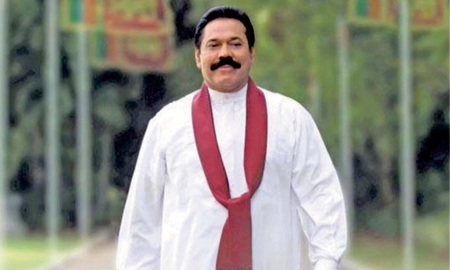Having beaten the terrorists, Sri Lankan President Mahinda Rajapaksa is bringing peace and prosperity back to the island

President Rajapaksa is largely known for his defeat of the Liberation Tigers of Tamil Eelam (LTTE) in May 2009, a victory which took many western commentators by surprise. His supporters maintain he has since kept the country afloat with strong leadership, helping to foster economic growth despite the legacy of the 26-year civil war, and the devastating effects of the 2004 tsunami.
He hails from a political dynasty: his father, D.A. Rajapaksa represented the Hambantota district from 1947 to 1965, while his paternal uncle, D.M. Rajapaksa was State Councillor for Hambantota in the 1930s. He became the country’s youngest parliamentarian in 1970 at the age of 24, before following in his father’s footsteps and becoming leader of the Sri Lanka Freedom Party. He went on to become prime minister in 2004, and was elected to be president in the following year.
Rajapaksa’s uncompromising attitudes tempered with political experience make him a force to be reckoned with. Despite western pressure to compromise, he based his 2005 presidential campaign on firm opposition to the LTTE’s demands for independence.
“After thirty years of terrorism, we have suffered a lot. When I came to power in 2005, my priority was to eradicate terrorists,” President Rajapaksa says. “Terrorists can be in any part of the world; in the west or the south. They can be Norwegian, Sri Lankan or Muslim. There are no good or bad terrorists as such – a terrorist is a terrorist.”
A man of his word, Rajapaksa did everything in his power to defeat terrorism in Sri Lanka. After four years of brutal fighting, Rajapaksa finally prevailed and ended the war. The President gained popularity following this victory, and soon succeeded in his bid for re-election in 2010. Since the end of the war, President Rajapaksa has made reconciliation among ethnic groups and displaced communities a priority. “Without peace we cannot have development and vice versa, so my next priority is development,” he says.
If winning the war was one thing, establishing and maintaining peace is another... Though President Rajapaksa has won over many with his charisma and his triumph over the LTTE, he is still faced with opposition by much of the Tamil community. Consequently, President Rajapaksa is focusing on improving the Sri Lankan economy and the country’s development. With a developing economy and increased prosperity for all, the likelihood of a terrorist revival is lessened.
His people-oriented manifesto “Mahinda Chinthana” (The Thinking of Mahinda) outlines his policy on a number of issues such as poverty alleviation, developing the small and medium enterprise (SME) sector, improving trade, education, the environment, the humane treatment of animals, the maritime and aviation industries, the energy industry, and the development of all regions of the country.
“I wanted to develop the villages, the rural areas and the whole country,” says President Rajapaksa. “If the whole country is not developed, there is no development.”
Much of the development is concentrated on the president’s interest in making Sri Lanka a hub in Asia. The Mahinda Chinthana promises to make Hambantota an intermediate stopover harbour, serving the great number of ships that pass between Europe and Asia. Related developments will surround the 2016 South Asian games which will be held in Sri Lanka, as well as the 2018 Commonwealth Games, which Sri Lanka hopes to host in Hambantota.
"I am determined to make our country the centre of the Asian Silk Route once again, taking advantage of its unique geographical location. I intend to develop it into a navigation, aviation, trading and commercial centre linking the East and West".
0 COMMENTS